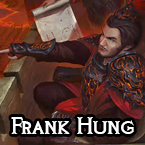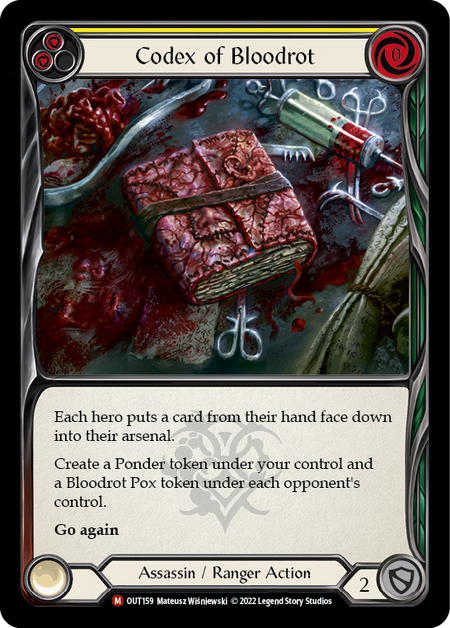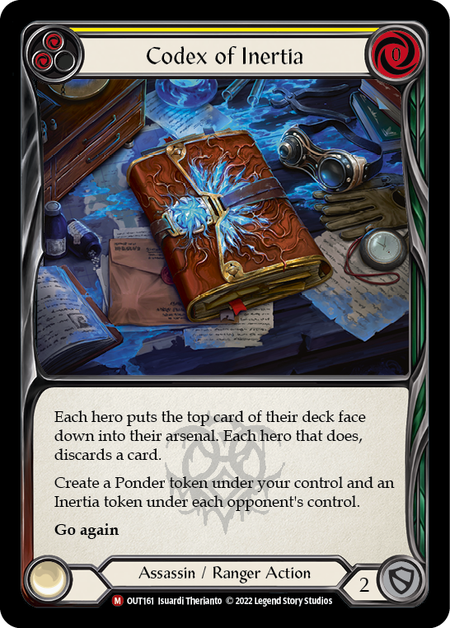
At this point, I think it’s indisputable that Codex of Frailty is the strongest card in Outsiders. I think the design was a home run for LSS on several fronts - and a minor red flag on a few fronts as well.
The entire Codex cycle is just super cool design, interacting with the arsenal slot, and having some opportunity cost for a potentially large benefit. In addition, you give the associated disease token to your opponent, and you get a Ponder on top of it. These cards are basically debuffing cantrips that have an additional effect, and generally require good sequencing to get the highest value out of them.
Overall, I can definitely see how LSS designed this card holistically in the context of the two classes that can play it: Assassin and Ranger. Being able to find your best attacks or most relevant on-hits for a game situation is something that improves the gameplay of these two classes a lot. In addition, as Bryan Gottlieb said, the two classes have historically not seen a lot of competitive success (except Lexi!), and it’s evident they adjusted the power level of this card to try to bolster the classes’ place in the metagame.




The main concerns I see being brought up about Codex of Frailty are:
- It's above power level for a regular card.
- The disruption and forced discard are unavoidable and just feel bad.
- There's not way to play around it.
To the first point, it's not a regular card. Codex of Frailty is a 'power card' meant to be played by specific classes that have been having trouble finding their spot in the meta - in the case of Ranger, this struggle has gone on for years. Power cards exist in every class, and it's intentional design that keeps the game spicy and exciting.
To the second and third points, it is undeniably disruption you cannot play around, and sure it feels bad. So do Winter's Bite and Coronet Peak; being forced to discard cards feels bad. But it's disingenuous to say there's no way to benefit from this, considering you can also grab one of your power attacks to swing back at the enemy with.

To expand on the concerns, I see the following as elements needing to be considered when discussing this - and other - controversial cards.
- Individual Card Power Level: The power level of individual cards (usually majestics. but not always) is something that I am sure LSS pays attention to.
Codex is both incredibly powerful on its own, and also plays well in really large hand sizes. I would personally prefer cards and heroes tend towards requiring synergies for payoffs of this level. For Assassin, because they usually (but not always) play smaller hand sizes, this card was sort of necessitated to be designed so that it would work on its own. But because of how good it is in larger hand sizes as well, the result is that the raw power of this card exceeds almost any other card in your 60, and pushes game results towards "did I draw more Codex (or Mordred Tide or Channel Mount Heroic or Crippling Crush) than my opponent?"
Generally I prefer when cards are designed to only reach their power peak either when you meet specific restrictions in deckbuilding (e.g. Belittle and 3-power attacks) or innately (Rangers with Three of a Kind and arrows).
Obviously there can be a spectrum of individual card performance. Consider the relatively high floor of all of Guardian cards, compared to the peaks and valleys of Rangers. When the floor is fairly low, as it is in Ranger/Assassin, it makes sense there would be some higher peaks.
- Ubiquity: The fact that LSS was willing to print a card of this power level on a hybrid card is eyebrow-raising as far as how pushed they want to or even intend for hybrid cards to be.
I think they can do a good job, and maybe even Codex of Frailty falls within that framework, because decks do need staples. But too many high power cards that are universally available homogenizes deck construction choices when these types of cards exceed a critical mass. I don't think we're close to that point yet for Ranger/Assassin, but it’s something to look out for. For the time being, you can see based on the card inclusions in heroes of both classes that there isn't actually a super strong preference towards playing a full deck of generics/hybrid cards.
- Gameplay Experience: This is my least critical point, personally, but I definitely do see where other people are coming from with this.
The gameplay experience can be unfun for the opponent when you play this card, especially in the two classes with lots of on-hits already, before they even start to recur the most relevant ones for any given scenario. As a result, it can leads to a type of "when it rains it pours" feeling for players. It feels the worst in Ranger mirrors in particular, where you can lock your opponent out of meaningful choices on defense, and set back their counter with disruption as well as the free frailty token.
Are the factors above enough to denounce a card as in need of a ban? Perhaps they make a strong argument. But let’s continue to evaluate the complete context.

Let's take a moment to talk about power cards in general. Bloodrush Bellow is an excellent example. This card can easily produce 18+ damage turns with only a pair of Mandible Claws and a standard 6-power Brute attack. Whats the counter for these power turns? You get defensive, write off the turn cycle, and hope that when you reset on the other side they don't have nearly as powerful a turn. You only have to survive 2-3 of these turns per game; without them you can keep up tempo on Rhinar easily.

Perhaps it's because Bellow has always been a part of the game, but this is a power card that has never been called broken or overtuned or anything like that. Without this card, Rhinar would be hardly competively viable, and people understand that. The majority of the Brute gameplan is to give away cards in pursuit of the power turns, and Bloodrush Bellow is the primary payoff that decks are anchored around.
But that's just one deck, and Codex of Frailty threatens to make an impact across two classes. Does that change the calculus at all? To that point, a fair comparison might be made to Art of War.

In many decks, Art of War is maybe gaining a value of +2 attack- but when slotted into the highly aggressive Fai, you are usually playing it out with a full hand and an extra card from the draw. Most of Fai's cards are roughly attacking for 3 value, so it's going from a normal turn value of 12 damage consistently, to 16 or more; and on top of that, it's pushing all of Fai's 3-power attacks to break points. In this case, one card creates a power turn that can shift the tide of the game - or outright end it.
How did the community respond to this? We realized most Fais will have a power turn at least once during a game; and if they do, we have to make sure we can survive it. We learned smart blocks that prevent Mask of Momentum triggers. We also learned to pressure the arsenal more, as Fai gets much more out of an Art of War turn when he's working with 5 cards. We now know there are many counterplays to this card, but also that there's plenty of room to take down Fai around the edges of his power spike turns.
I don't want to touch on every single power card in the game, but a few quick examples include Steelblade Supremacy, Blazing Aether, Crippling Crush, Herald of Erudition, and Lumina Ascension. In fact, every hero has key cards that create power turns - and when they're played against you, it's always the same thing: "I just have to survive this turn, and then I can come back." In time, Codex of Frailty will also settle into this pattern.

I think that getting to play powerful cards can be the best part about Flesh and Blood. Since the Briar era, I’ve been of the mind that LSS should print more powerful cards and synergies to reward good deckbuilding and the opportunity cost of keeping your whole hand to do something powerful. I would say the very high floor of Codex of Frailty technically falls outside of that design idea, since it's equally powerful from large and small hands; but it is a reasonable signal that LSS is not intending to continue reducing the power level of the metagame.

It must also be said that LSS has banned cards, and they provide useful framework to analyze the present situation. Let's look at some cards that were chosen to be banned by LSS. Many bans have occurred to change play patterns for meta-leading decks after months of gameplay proved a need to take them down a peg; using these 'power level adjustment' and 'meta shakeup' cards as benchmarks for comparison is suspect, as they were largely victims of a desire to slow down dominant decks, so we'll instead focus on bans that either occurred quickly after release or hit general use cards, where the banning cannot be attributed directly to format balance.
Let's start with Awakening - a solid comparison, as both Awakening and Codex allow you to seek out an ideal attack and can represent powerful pivot turns. Reading it with fresh eyes, this card just sounds ridiculous. If you have a 10-health difference, you can grab basically any attack in the game and play it for free.

When Awakening was banned, Bravo, Star of the Show was at his apex - but Awakening was not necessarily a component in his success. Rather, Awakening served as an insurance policy that could be utilized should any other decks find a way to out-pace Elemental Guardians in the future. Per LSS:
"Awakening has fallen into a place where it single-handedly trades for the most explosive turns an opponent can unleash, for little cost. Awakening effectively trades the time and resources an opponent spends setting-up their high impact synergies, for a devastating retaliation in the form of effectively a 2 cost Pulverize, Crippling Crush, or Spinal Crush... With the banned and suspended changes today, we are hoping to see a more diverse range of proactive decks become viable tournament choices. Awakening remaining in the format, in our view, would be contrary to that objective."
Could Codex of Frailty one day fit that discription? It's unlikely. The combination of Guardian's elevated attack power levels and Awakening's discount make it much more potent than the card Codex can arsenal for you. The absolute rally that Awakening facilitated just isn't there.


When LSS announced the Duskblade ban, they said "it presents a game of a player VS Duskblade, rather then a player playing Flesh and Blood". Basically, the card created a very one-dimensional experience, because Duskblade was always there. Its power impacted every turn of the game.
Similarly, Drone of Brutality was the first to be banned, and the reason was for creating an endgame loop that prevented fatigue losses. Drone was not a factor from the beginning of the game, but at a certain point it became the predominant element of gameplay.
These bans show a clear objective of 'cards that play an outsized role in the deck are on thin ice'. Codex is not that kind of card. Its impact on the game is limited to the turn cycle it's played during.

Do I think Codex of Frailty is banworthy?
I don't think so. Not yet, anyway.
The fact is that Rangers may push the metagame to slow down, which opens the door for Assassins to have a role as well. I know this sounds counter-intuitive when we just had Oldhim and Iyslander on top of the metagame, but outside of Oldhim’s inherently oppressive nature towards aggro decks, a lot of the more aggressive decks in the format were still trying to play towards minimally interactive games. More on-hit effects that demand respect will drive decks to become more well-rounded, with defense reactions and other novel ways to block. This has the potential to create an exciting post-Oldhim meta landscape. Codex of Frailty makes gameplay more dynamic, rather than more decided.

Where does Codex of Frailty fall? Undeniably, it's a power card, but does it produce a game altering effect that opponents can't come back from? Does it modify the fundamentals of the game? Or does it simply represent the spike in a deck's game progression?
I'll let you decide.






